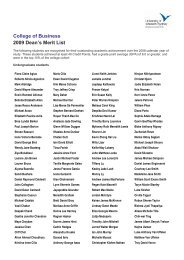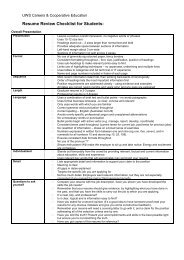Mate-selection and the Dark Triad - University of Western Sydney
Mate-selection and the Dark Triad - University of Western Sydney
Mate-selection and the Dark Triad - University of Western Sydney
Create successful ePaper yourself
Turn your PDF publications into a flip-book with our unique Google optimized e-Paper software.
P.K. Jonason et al. / Personality <strong>and</strong> Individual Differences 51 (2011) 759–763 763<strong>of</strong> sex partners (Jonason et al., 2009), <strong>and</strong> correlated with life outcomedata like risk-taking (Jonason, Koenig, & Tost, 2010a). In <strong>the</strong>present study, we have extended our underst<strong>and</strong>ing <strong>of</strong> <strong>the</strong> <strong>Dark</strong><strong>Triad</strong> by correlating <strong>the</strong>m with mate preferences. The <strong>selection</strong> <strong>of</strong>mates is an important context in which to underst<strong>and</strong> any personalitytrait (Buss, 1984a, 1987). In order to facilitate <strong>the</strong> short-termmating strategy in men that appears to be manifested in <strong>the</strong> <strong>Dark</strong><strong>Triad</strong> (Jonason, Li, & Buss, 2010b; Jonason et al., 2009), <strong>the</strong>se individualsmay create a ‘‘target-rich’’ environment by having lowst<strong>and</strong>ards in <strong>the</strong>ir mates. In addition, we have shown that thosehigh on psychopathy may create mating contexts that are volatile<strong>and</strong> choose mates who are similar to <strong>the</strong>m in terms <strong>of</strong> being low onkindness.ReferencesBaron, R. M., & Kenny, D. A. (1986). The moderator–mediator variable distinction insocial psychological research: Conceptual, strategic, <strong>and</strong> statisticalconsiderations. Journal <strong>of</strong> Personality <strong>and</strong> Social Psychology, 51, 1173–1182.Bhattacharya, S. (2010). What’s so right about Mr Wrong. Psychologies.Block, J. (2000). Three tasks for personality psychology. In L. R. Bergman, R. B. Cairns,L. Nilsson, & L. Nystedt (Eds.), Developmental science <strong>and</strong> <strong>the</strong> holistic approach(pp. 155–164). Mahwah, NJ: Erlbaum.Bushman, B. J., & Baumeister, R. F. (1998). Threatened egotism, narcissism, selfesteem,<strong>and</strong> direct <strong>and</strong> displaced aggression: Does self-love or self-hate lead toviolence? Journal <strong>of</strong> Personality <strong>and</strong> Social Psychology, 75, 219–229.Buss, D. M. (1984a). Toward a psychology <strong>of</strong> person-environment (PE) correlation:The role <strong>of</strong> spouse <strong>selection</strong>. Journal <strong>of</strong> Personality <strong>and</strong> Social Psychology, 47,361–377.Buss, D. M. (1984b). Marital assortment for personality dispositions: Assessmentwith three data sources. Behavior Genetics, 14, 111–123.Buss, D. M. (1987). Selection, evocation, <strong>and</strong> manipulation. Journal <strong>of</strong> Personality <strong>and</strong>Social Psychology, 53, 1214–1221.Buss, D. M. (1989). Sex differences in human mate preferences: Evolutionaryhypo<strong>the</strong>ses tested in 37 cultures. Behavioral & Brain Sciences, 12, 1–49.Buss, D. M., & Barnes, M. L. (1986). Preferences in human mate <strong>selection</strong>. Journal <strong>of</strong>Personality <strong>and</strong> Social Psychology, 50, 559–570.Buss, D. M., & Schmitt, D. P. (1993). Sexual Strategies Theory: An evolutionaryperspective on human mating. Psychological Review, 100, 204–232.Campbell, W. K., & Foster, C. A. (2002). Narcissism <strong>and</strong> commitment in romanticrelationships: An investment model analysis. Personality <strong>and</strong> Social PsychologyBulletin, 28, 484–495.Carmines, E. G., & Zeller, R. A. (1979). Reliability <strong>and</strong> validity assessment.Quantitative applications in <strong>the</strong> social sciences series (Vol. 17). Newbury Park,CA: Sage.Christie, R., & Geis, F. L. (1970). Studies in Machiavellianism. New York: AcademicPress.Clark, R. D., III, & Hatfield, E. (1989). Gender difference in receptivity to sexual <strong>of</strong>fers.Psychology <strong>and</strong> Human Sexuality, 2, 39–55.Cohen, J., Cohen, P., West, S. G., & Aiken, L. S. (2003). Applied multiple regression/correlation analysis for <strong>the</strong> behavioral sciences (3rd ed.). Mahwah, NJ: Erlbaum.Epstein, M., Calzo, J. P., Smiler, A. P., & Ward, L. M. (2009). ‘‘Anything from makingout to having sex’’: Men’s negotiations <strong>of</strong> hooking up <strong>and</strong> friends with benefits.The Journal <strong>of</strong> Sex Research, 46, 414–424.Foster, J. D., Shrira, L., & Campbell, W. K. (2006). Theoretical models <strong>of</strong> narcissism,sexuality, <strong>and</strong> relationship commitment. Journal <strong>of</strong> Social <strong>and</strong> PersonalRelationships, 23, 367–386.Gosling, S. D., Rentfrow, P. J., & Swann, W. B. Jr., (2003). A very brief measure <strong>of</strong> <strong>the</strong>Big-Five personality domains. Journal <strong>of</strong> Research in Personality, 37, 504–528.Hamilton, W. D. (1964). The genetical evolution <strong>of</strong> social behavior: I <strong>and</strong> II. Journal <strong>of</strong>Theoretical Biology, 7, 1–52.Hare, R. D. (1996). Psychopathy: A clinical construct whose time has come. CriminalJustice <strong>and</strong> Behavior, 23, 25–54.Jackman, P. (2008). Why bad boys get girls. Globe<strong>and</strong>Mail.Jakobwitz, S., & Egan, V. (2006). The dark triad <strong>and</strong> normal personality traits.Personality <strong>and</strong> Individual Differences, 2, 331–339.Jonason, P.K., Luévano, V.X., Kaufman, S.B., Adams, H.M., & Geher, G. (submitted forpublication). Shedding light on <strong>the</strong> <strong>Dark</strong> <strong>Triad</strong>: The validity <strong>and</strong> nomologicalnetwork <strong>of</strong> <strong>the</strong> Dirty Dozen.Jonason, P. K., & Kavanagh, P. (2010). The dark side <strong>of</strong> love: The <strong>Dark</strong> <strong>Triad</strong> <strong>and</strong> lovestyles. Personality <strong>and</strong> Individual Differences, 49, 606–610.Jonason, P. K., Koenig, B., & Tost, J. (2010a). Living a fast life: Psychopathy links <strong>the</strong><strong>Dark</strong> <strong>Triad</strong> to Life History Theory. Human Nature, 21, 428–442.Jonason, P. K., Li, N. P., & Buss, D. M. (2010b). The costs <strong>and</strong> benefits <strong>of</strong> <strong>the</strong> <strong>Dark</strong><strong>Triad</strong>: Implications for mate poaching <strong>and</strong> mate retention tactics. Personality<strong>and</strong> Individual Differences, 48, 373–378.Jonason, P. K., Li, N. P., & Richardson, J. (2010c). Positioning <strong>the</strong> booty-callrelationship on <strong>the</strong> spectrum <strong>of</strong> relationships: Sexual but more emotionalthan one-night st<strong>and</strong>s. The Journal <strong>of</strong> Sex Research, 47, 1–10.Jonason, P. K., Li, N. P., Webster, G. W., & Schmitt, D. P. (2009). The <strong>Dark</strong> <strong>Triad</strong>:Facilitating short-term mating in men. European Journal <strong>of</strong> Personality, 23, 5–18.Jonason, P. K., & Tost, J. (2010). I just cannot control myself: The <strong>Dark</strong> <strong>Triad</strong> <strong>and</strong> selfcontrol.Personality <strong>and</strong> Individual Differences, 49, 611–615.Jonason, P. K., & Webster, G. D. (2010). The Dirty Dozen: A concise measure <strong>of</strong> <strong>the</strong><strong>Dark</strong> <strong>Triad</strong>. Psychological Assessment, 22, 420–432.Jones, D. N., & Paulhus, D. L. (2010). Different provocations trigger aggression innarcissists <strong>and</strong> psychopaths. Social Psychological <strong>and</strong> Personality Science, 1,12–18.Kanazawa, S., & Still, M. C. (1999). Why monogamy? Social Forces, 78, 25–50.Kenrick, D. T., Groth, G. E., Trost, M. R., & Sadalla, E. K. (1993). Integratingevolutionary <strong>and</strong> social exchange perspective on relationships: Effects <strong>of</strong>gender, self-appraisal, <strong>and</strong> involvement level on mate <strong>selection</strong> criteria.Journal <strong>of</strong> Personality <strong>and</strong> Social Psychology, 64, 951–969.Kline, P. (2000). The h<strong>and</strong>book <strong>of</strong> psychological testing (2nd ed.). London: Routledge.Kowalski, R. M. (Ed.). (2001). Behaving badly: Aversive behaviors in interpersonalrelationships. Washington, DC: American Psychological Association.Lee, K., & Ashton, M. C. (2005). Psychopathy, Machiavellianism, <strong>and</strong> narcissism in<strong>the</strong> Five-Factor Model <strong>and</strong> <strong>the</strong> HEXACO model <strong>of</strong> personality structure.Personality <strong>and</strong> Individual Differences, 38, 1571–1582.Li, N. P., Bailey, J. M., Kenrick, D. T., & Linsenmeier, J. A. W. (2002). The necessities<strong>and</strong> luxuries <strong>of</strong> mate preferences: Testing <strong>the</strong> trade<strong>of</strong>fs. Journal <strong>of</strong> Personality<strong>and</strong> Social Psychology, 82, 947–955.Li, N. P., & Kenrick, D. T. (2006). Sex similarities <strong>and</strong> differences in preferences forshort-term mates: What, whe<strong>the</strong>r, <strong>and</strong> why. Journal <strong>of</strong> Personality <strong>and</strong> SocialPsychology, 90, 468–489.Li, N. P., Valentine, K. A., & Patel, L. (2011). <strong>Mate</strong> preferences in <strong>the</strong> U.S AndSingapore: A cross-cultural test <strong>of</strong> <strong>the</strong> mate preference priority model.Personality <strong>and</strong> Individual Differences, 50, 291–294.Manning, W., Giordano, P., & Longmore, M. (2006). Hooking up: The relationshipcontexts <strong>of</strong> ‘‘nonrelationship‘‘ sex. Journal <strong>of</strong> Adolescent Research, 21, 459–483.McAdams, D. P. (1992). The five-factor model in personality: A critical appraisal.Journal <strong>of</strong> Personality, 60, 329–361.McDonald, K. (1995). The establishment <strong>and</strong> maintenance <strong>of</strong> socially imposedmonogamy in <strong>Western</strong> Europe. Politics <strong>and</strong> <strong>the</strong> Life Sciences, 14, 3–23.Miller, J. D., Dir, A., Gentile, B., Wilson, L., Pryor, L. R., & Campbell, W. K. (2010).Searching for a vulnerable <strong>Dark</strong> <strong>Triad</strong>: Comparing factor 2 psychopathy,vulnerable narcissism, <strong>and</strong> Borderline Personality Disorder. Journal <strong>of</strong>Personality, 78, 1529–1564.Paulhus, D. L., & Williams, K. M. (2002). The dark triad <strong>of</strong> personality: Narcissism,Machiavellianism, <strong>and</strong> psychopathy. Journal <strong>of</strong> Research in Personality, 36,556–563.Schmitt, D. P. (2005). Sociosexuality from Argentina to Zimbabwe: A 48-nationstudy <strong>of</strong> sex, culture, <strong>and</strong> strategies <strong>of</strong> human mating. Behavioral <strong>and</strong> BrainSciences, 28, 247–275.Schmitt, D. P., & Buss, D. M. (2000). Sexual dimensions <strong>of</strong> person description:Beyond or subsumed by <strong>the</strong> Big Five? Journal <strong>of</strong> Research in Personality, 34,141–177.Schmitt, D. P., & Shackelford, T. K. (2008). Big Five traits related to short-termmating: From personality to promiscuity across 46 nations. EvolutionaryPsychology, 6, 246–282.Simpson, J., & Gangestad, S. (1991). Individual differences in sociosexuality:Evidence for convergent <strong>and</strong> discriminant validity. Journal <strong>of</strong> Personality <strong>and</strong>Social Psychology, 60, 870–883.Stagner, R. (1994). Traits <strong>and</strong> <strong>the</strong>oreticians. Psychological Inquiry, 5, 166–168.Symons, D. (1979). The evolution <strong>of</strong> human sexuality. New York: Oxford <strong>University</strong>Press.Vernon, P. A., Villani, V. C., Vickers, L. C., & Harris, J. A. (2008). A behavioral geneticsinvestigation <strong>of</strong> <strong>the</strong> <strong>Dark</strong> <strong>Triad</strong> <strong>and</strong> <strong>the</strong> Big 5. Personality <strong>and</strong> IndividualDifferences, 44, 445–452.



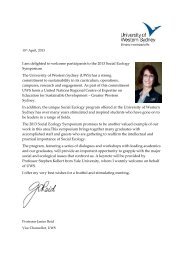
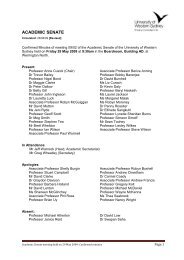
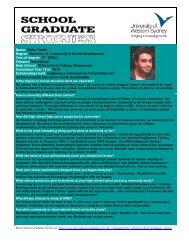
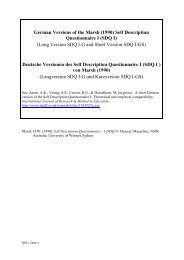
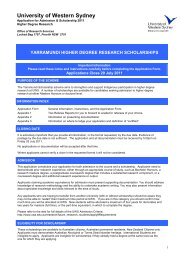


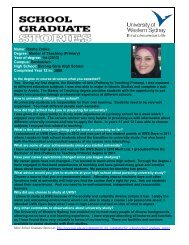
![Glossary of terms for Academic Integration Plans [PDF, 127Kb]](https://img.yumpu.com/46838287/1/184x260/glossary-of-terms-for-academic-integration-plans-pdf-127kb.jpg?quality=85)

